My First Trip Via Megabus
This post is about my first trip on Megabus, roundtrip from St. Louis to Chicago.
In January 2012 I emailed Megabus asking about making online reservations for a trip that would include my wheelchair. At that time there was only one way to do it, as this reply indicates:
Currently the only way to reserve for a special needs request is thru our toll free # at 877-463-6342. I am sorry this is uncomfortable for you but the good news is that you will be able to make this request online in the very near future. My understanding is that the developers of our website have made this feature a priority.
I’d explained my uneasiness with making phone calls, they don’t have a station like Greyhound & Amtrak.
In mid-June I was able to make online reservations for myself and my husband to visit Chicago last weekend. As promised in 2012, the website now allows me to indicate I’d need room for my wheelchair. I’ve been on Amtrak & Greyhound with the wheelchair, I didn’t know what to expect with Megabus, neither of us had used Megabus before.
To make the most of a 3-day weekend in Chicago we booked a bus leaving at 3:05am on Friday, August 1st (his birthday). A week before we got an email saying the departure would be delayed 15 minutes.
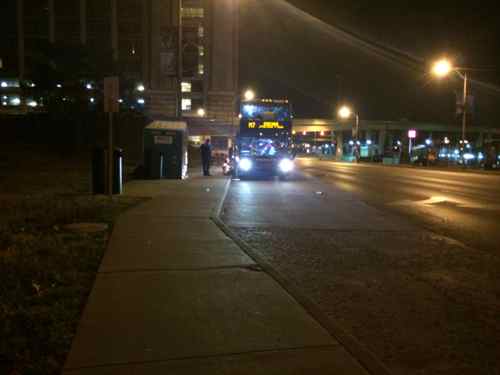
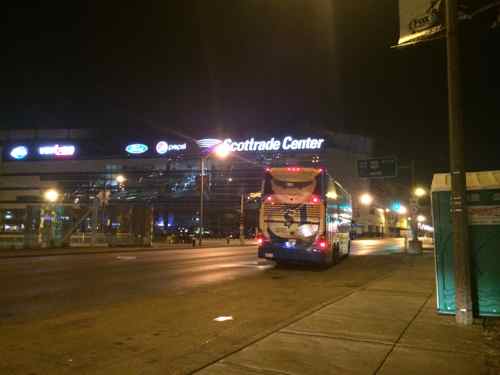
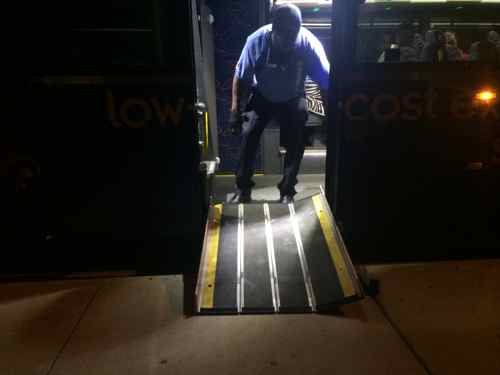
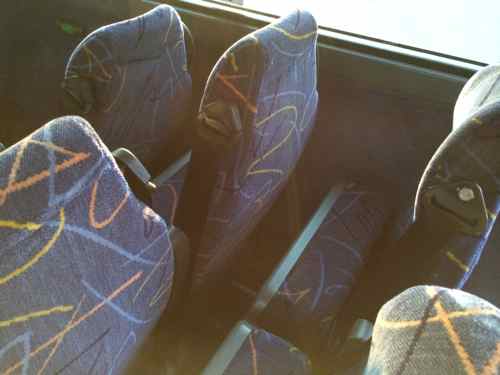
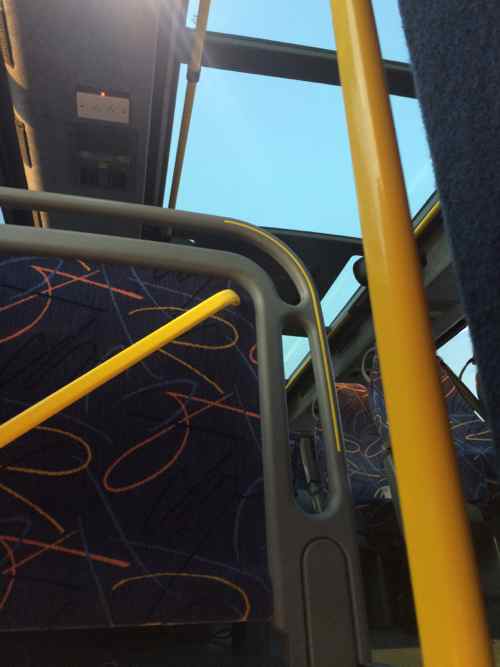
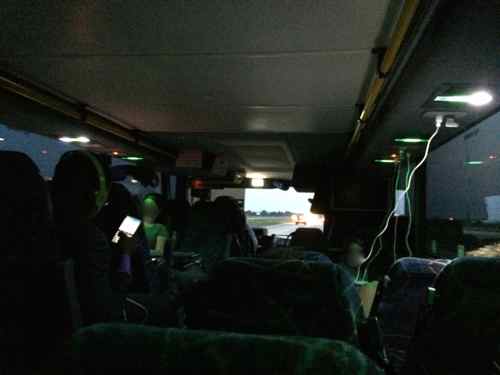
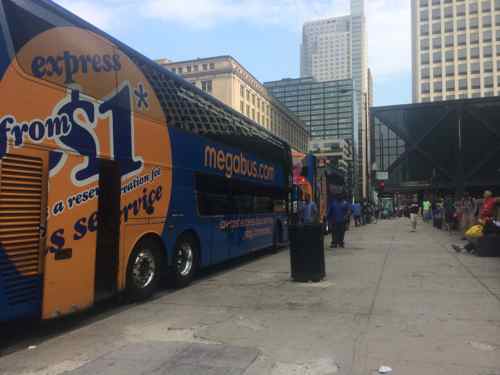
Others waiting with us on 14th Street didn’t like the new St. Louis stop being located on 14th Street, it used to be west of St. Louis’ Union Station, because of a lack of a parking lot. We walked to the stop from our loft. Via email:
Until **Monday** July 7th 2014, the Megabus stop for all arrivals and departures in St. Louis will be located West of Union Station on the East Side of 21st St near the intersection of Clark St and 21st St. The bus stop will not be in use after this date.
From **Monday** July 7th 2014 onwards, the megabus stop will be located on the Northbound side of S 14th Street, between Spruce Street and Clark Avenue.
The bus to Chicago originated in Dallas/Ft. Worth, with stops in Little Rock & Memphis, before coming to St. Louis. As such, many seats were taken. The bus had two drivers, they switched during the break halfway to Chicago.
The return bus had only one driver, who returned to Chicago. Next trip I’ll book a bus that isn’t coming from Memphis so it’ll be empty when we board, allowing my husband to sit across the aisle from me. It seemed like the trip up the drivers were speeding while the return trip the driver stuck to the speed limit. Both arrived basically on time.
When we rolled up to both buses I was greeted by name, they were expecting me. I wasn’t expecting such personal service for a low-cost carrier.
I still prefer rail travel, but Amtrak costs more and they’re currently doing track work, so Amtrak is using charter buses.
The cheapest dates to travel on Megabus, like airlines, is Tuesdays & Wednesdays. Glad to have another option to reach Chicago, Kansas City, and others.
— Steve Patterson
Great article as always, Steve. What was the round trip fare? How did the fare roughly compare against Amtrak, Greyhound & Amtrak?
Thanks, we paid roughly $55 roundtrip total for both of us. Amtrak would’ve been 2-3x more.
Which just reinforces the arguments against continued subsidies for Amtrak – the unsubsidized bus worked better, cost you two less to ride and required no direct government subsidy!
So wrong! The unsubsidized Megabus ignores nine stops served by Amtrak: Summit, Joliet, Dwight, Pontiac, Bloomington-Normal, Lincoln, Springfield, Carlinville, and Alton
And how often do you plan on using Amtrak to visit Summit, Joliet, Dwight, Pontiac, Lincoln, Carlinville, or Alton? If a tree falls in a forest and no one hears it fall, does it make a noise? Our resources, both financial and natural, are limited. We shouldn’t be wasting our taxes on infrastructure that people “might” or “should” use, we should be focused on what people actually do use!
You do realize that people live in, or near, these communities? The track goes through there so it makes sense to stop for a few minutes to connect these people to Chicago, Springfield (their state capital), and St. Louis.
Government subsidies are needed where the private market fails.
Of course I “realize that people live in, or near, those communities”. The question is how many of those people, in the 21st Century, need, want or will use anything other than their own or their neighbor’s pickup, SUV or sedan to get anywhere? When the train stops, as it does in Kirkwood, every day, how many passengers get on or off? One? Three? None? Much like the Sunnen Station on Metrolink’s Blue Line, the opportunity is there, but few people take advantage of it. And those “few minutes” add up – because Amtrak stops nine times on every trip between here and Chicago, it adds at least a half hour to the trip. You may have the luxury of unlimited time, but most travelers want to get to their destinations as quickly as possible. The reason Megabus runs nonstop is because that’s what the vast majority of its customers (including you two) want, to get from here to there as quickly as possible and “to make the most of a 3-day weekend in Chicago”.
Rural America drives, it doesn’t use buses (except school buses). 80% of Amtrak’s business is in the northeast corridor. Everything west of the Appalachians is there solely for political reasons, to get the votes to justify continued subsidies. Air travel serves the vast majority of travelers wanting to go more than 500 miles, and Megabus and Greyhound provide a robust, more-affordable alternative. I’ll repeat, we have LIMITED resources. The money ($8 million a year to get 200,000 boardings / $40 per ticket sold) Missouri has “invested” in subsidizing Amtrak service in the state would have been better spent rebuilding I-70 or incentivizing better bus service.
Of the towns/cities I listed, Greyhound only serves Springfield on some trips. The only long distance transit service to the others is Amtrak.
Rural bus service faded away because riders quit riding. No revenue = no service. Most people would rather drive . . . .
The auto is heavily subsidized, many of the subsidies are hidden. Police and ambulance calls for instance, but even something like sewers, where 100 foot length in the city might serve 8 homes while in areas of sprawl the sewer system might serve 4 or maybe only 2 homes. All utilities are the same, with the city resident in effect subsidizing the auto lifestyle since rates for usage are the same whether you live in a dense area or in sprawl.
Then of course there is pollution, we even have signs along the highway encouraging carpooling on high pollution days, the health and associated costs are real.
And then there is the elephant in the room, global warming, which autos are a big part of, yet there is no cost associated with the auto.
There are other hidden costs of the auto, The point is Amtrak has visible subsidies, yet the auto is a true subsidy hog if any real road pricing is undertaken.
Development of a sustainable transport system will not be possible if we ignore the true costs of the automobile to society.
My argument is Megabus versus Amtrak. We are subsidizing every trip taken on Amtrak in Missouri to the tune of $40 per ticket, and that’s for 200,000 trips annually. If that same $40/trip subsidy were given to private motor vehicles, one, we could never afford it, and two, the annual number of Amtrak riders in the state is far less than just one day’s number of trips in just the St. Louis area. Subsidies should (and most do) go to the types of transportation most people CHOOSE to use!
I support public transit, intercity buses and airline travel; I do not support Amtrak outside of the northeast corridor for the same reason I don’t support the Delmar trolley – buses provide the same service for less money and are better able to adjust / fine tune their service to peaks and valleys in demand. Just because a small minority of our citizens “like” trains more than buses is no reason to throw stupid amounts of taxpayers dollars at them to keep them running, in hopes there will magically be more ridership! Taxes shouldn’t be going to support hobbies, taxes should be going to deliver services as efficiently as possible!
Are autos subsidized? Absolutely! That’s why we pay taxes. However, every other form of transportation is subsidized, as well, in some form or another. The big difference between me (and my truck or car) and Megabus versus Metro Transit and Amtrak is that the former pays the full cost of acquiring, fueling, insuring, maintaining and operating their vehicles while the latter rely on significant (50%-80%) government subsidies, paid for by a bunch of taxpayers who NEVER use their services, to do the exact same thing! If, by magic, everyone decided one day not to drive, then Metro’s and Amtrak’s direct subsidies would need to increase at least tenfold, taxes would need to go up by at least 20%-30%, and we’d all need to plan on taking a lot longer to get ANYWHERE! The development of our autocentric society is NOT an accident, it evolved over many decades based on the rational choices of many, many people.
Finally, the direct and indirect costs of sprawl – your sewer argument. Yes, pipe costs $X per foot, so longer runs do cost more than shorter runs to install – duh! But the real cost is not in the pipe, the cost is in treating and handling what’s inside the pipe, day in and day out. You don’t shit less if you live in an apartment, but you do generate more surface runoff if you have more impermeable area. Sewers last for decades, even centuries, so their initial costs are either amortized over many, many years or, more likely, paid directly by the new home buyer, through tap fees. But, to be fair, one utility cost that does increase with lower densities is the cost of providing water – residential irrigation, in the summer months, can easily exceed inside consumption, and systems need to be built/expanded to meet these peak demands.
As for pollution and global warming – in many cases, modern vehicles are generating pollution at barely measurable levels, and in some cases putting out exhaust that is cleaner than the ambient air levels – http://www.nytimes.com/2003/11/16/automobiles/low-cost-path-to-low-emissions.html . . To really address global pollution levels would require massive changes to industries in China and India, which in turn would require massive changes in how Americans consume. It would also require global zero population growth and/or a worldwide pandemic, both of which are highly problematic. Should we? Absolutely? Will we? I’m not holding my breath, literally or figuratively . . . .
Of course choice is between nothing and nothing. It is not like as I have mentioned previously where Stockholm planned for trains to new suburbs and now I think 80 per cent ride the train to central Stockholm during the work week.
You emphasis the word CHOOSE, but central to the argument is that there are NO MEANINGFUL CHOICES AVAILABLE.
St. Louis,East West Gateway Council (and MoDot) has an abysmal system of transit delivery for the general public. I would think a 80 per cent ridership would help cash flow.
But of course if urban design undermines mass transit, as it does in St. Louis and Missouri, then funds available to support mass transit will be less. What you are arguing is that poor urban design should be accepted and condoned.
Truthfully I don’t think you support public transit as you say. A comprehensive system of thought would likely eliminate any talk of expanding Highway 70 but rather work to enhance rail and other options for example.
It is not surprising there is not leadership, the Koch Bros and their wealthy corporate partners (in ALEC and so on) own most of government. There is no question that policies to keep mass transit working as a viable CHOICE are undermined by corruption and payoffs.
Problems have become serious already, we are drawing oil from the deepest oceans and converting sands into oil, it is clear we as a civilization are scraping the bottom of the oil barrel, but we continue with our folly.
The lack of support for mass transit in urban planning decisions is the start of that folly.
To be honest I think there will be a spectacular crash of all of your auto fantasies.
We’ll see
Otherwise we can just wait for global warming to really kick in. America should be in a leadership position, instead even China is now moving full bore into solar energy production. Bye Bye innovation in America, the land of conservative nay sayers.
(But hey a few people are getting rich beyond imagination, are we a great country or what?)
You can lead a horse to water, but you can’t make him drink. Between 1880 and 1920, (St. Louis and every other city) had a robust, public, mass transportation system focused on streetcars. It was affordable, faster and easier than walking, cheaper and easier than owning a horse, while bicycles were fairly crude devices. You assert that “the lack of support for mass transit in urban planning decisions is the start of that folly.” I’ll assert that advances in mass production and synthetic rubber, which made cars more affordable and more reliable, played a bigger role in shifting individual preferences away from mass transit and toward the individual vehicle, and that those preferences shifted our urban design choices to parking lots and away from transit and TOD.
There was a time when my grandparents owned no vehicles. There was a time when my parents owned only one vehicle for our growing family. There was a time when my parents owned two vehicles for a family of six. My wife and I (with no kids at home) now own three vehicles. I either rode the school bus or walked to school, all the way through high school. Today, the soccer mom and the minivan has replaced the school bus in grade school, while many (most?) high school kids either drive themselves or ride with friends to school. It’s the classic chicken-or-egg argument – do people mostly not use transit because transit isn’t very good? Or, is transit not very good because people don’t want to use it?!
Yes, the availability of good public transit is critical to denser urban planning. But until local residents CHOOSE to invest in denser residential choices (and not move to the suburbs) and CHOOSE to use mass transit (and not drive), we will continue to see the current “non-urban” design solutions because this is what most people WANT! Most people don’t want to wait for a streetcar, much less wait for a bus. They “want” to drive themselves because it’s easier, quicker and way more convenient. You may want to wear sack cloth instead cotton, but I’m only willing to make limited sacrifices in the name of the greater good, especially when few others are willing to make the same sacrifices and when most people look at using public transit as being weird.
In the teens and 1920s St. Louis spent massive sums of money subsidizing the automobile, simultaneously destroying mass transit, by widening street after street. See 1928 photo in this post: http://www.urbanreviewstl.com/2009/12/harland-bartholomew-negatively-impacted-many-cities/
Because the city consciously wanted to destroy the streetcar system? Or because it was the fashion of the day/time, and the leaders of St. Louis didn’t want to be viewed as some fading, backwater town? Or was it like it is today, where our leaders were/are listening to the people and (re)investing in two, shiny, new streetcar lines? Neither you nor I were living, here or anywhere else, in the 1920’s. We don’t know how people viewed these steps to “modernize” the city – we only know what we read or what we assume. I’ve been around longer than you, I’ve listened to my parents and my grandparents embrace their cars, the interstate highway system and the suburbs. I’ve listened to them state a STRONG preference for having their own vehicles and their disdain for public transit. And I don’t think that their views were much different than those of their contemporaries. You may want to subscribe to some devious plot to destroy mass transit, I prefer to believe that most people CHOSE to buy cars and move to the suburbs after WW II for their own, greedy, self interests – they wanted (what they perceived to be, and mostly was) a better life for themselves and their children. Given the clarity of 20/20 hindsight, NO, not all of the decisions they made were the “right” ones, but that is true of the decisions everyone makes, today, fifty years ago, a century ago or 300 years ago! We can learn from our bad decisions, but I strongly believe that we live in a better country, today, than my parents, and especially my grandparents, did, thanks to the many, many good decisions they did make!
If one is flexible, there are are one way Amtrak tixes to Chicago available for $20.25 each, later this month. A similar tix to KC cost $22.50, except there are dates into September. Ride Amtrak and get points that in time will provide a free tix, along with Amtrak points discounted occasionally.
Now most Megabus routes have ‘cheap’ tixes, except one need to purchase early. Low price to Chicago is $15; but Megabus schedule doesn’t cover the Holiday yet. Competing against Megabus in some areas is the Greyhound Express, plus a few other bus lines on both coasts. Greyhound Express prices are in the same range as Megabus, except one can shop into 2015.
Supposedly, one might rent certain Enterprise cars beginning next month, Friday thru Monday @$9.95 per day plus fees. While this promo goes into March 2015, I was unable to find anything available on Enterprise website that cheap.